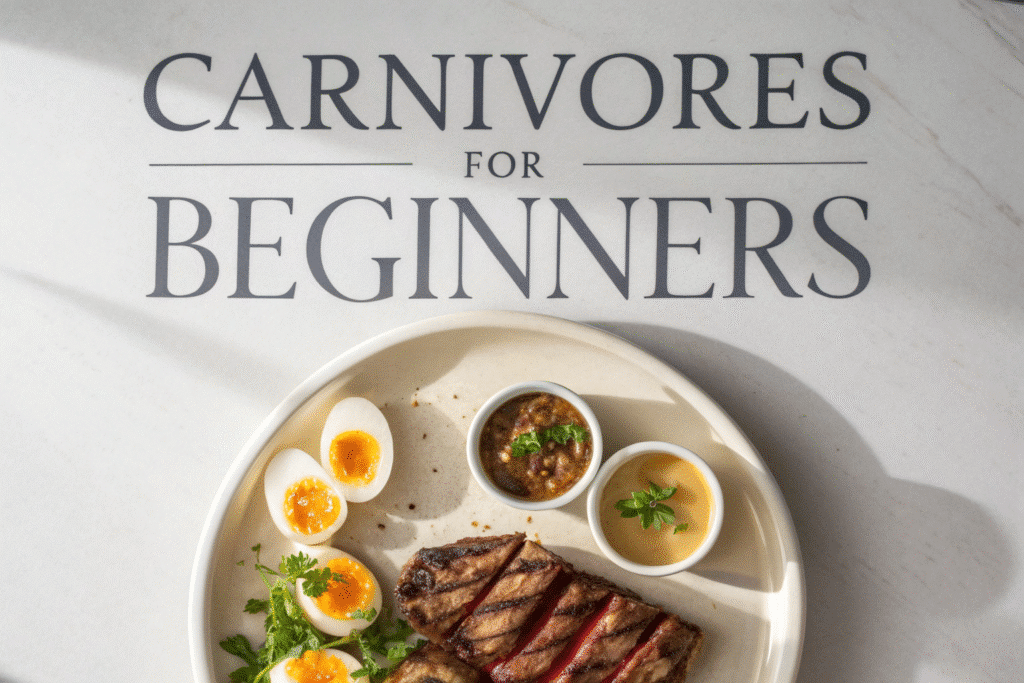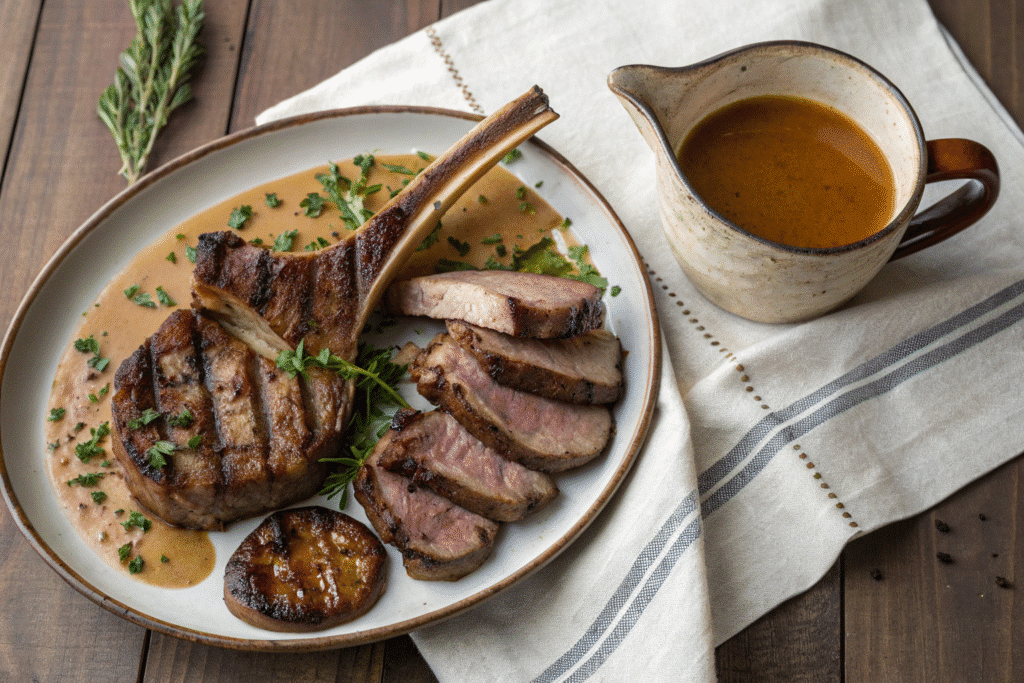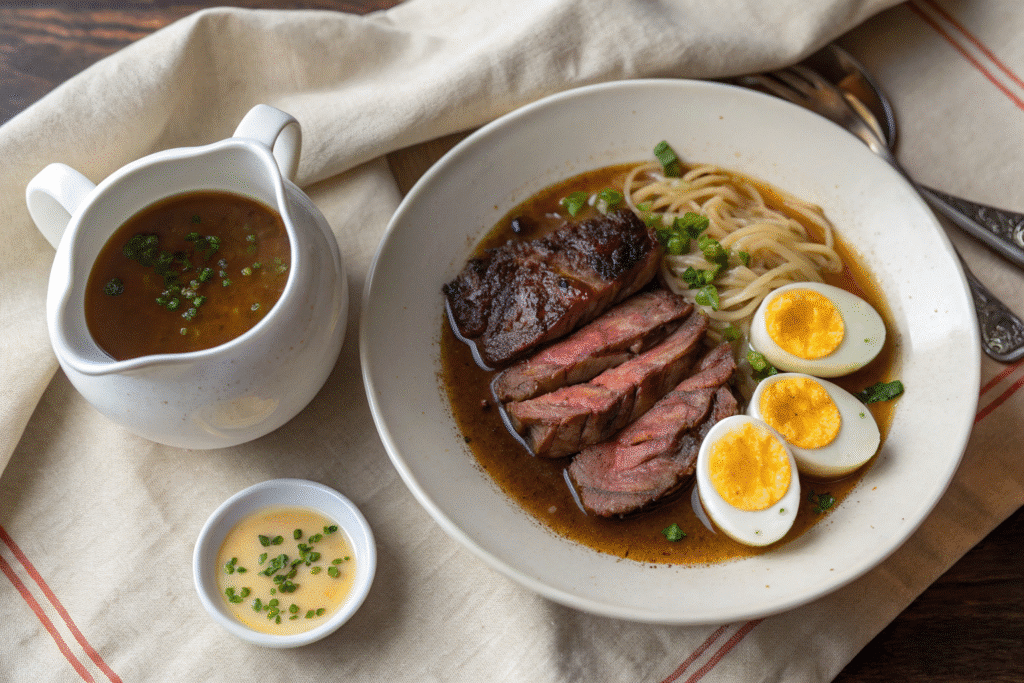Carnivores for beginners often feel overwhelmed by all the conflicting advice out there. That was me—bloated, tired, and totally frustrated with clean eating that left me foggy and starving. I needed a break from food rules and constant cravings. So I searched carnivores for beginners, desperate for a simple answer. And I found one: meat.
That first week changed everything. No more tracking, no more confusion—just nourishing animal foods that helped my body finally breathe. This guide shares exactly how I made that shift and what made it so powerful.
Table of Contents
Table of Contents

Carnivores for Beginners: Why I Gave Up Everything Else
What pushed me to go full carnivore
I didn’t start eating carnivore to follow a trend. I did it because I was exhausted—physically, emotionally, and metabolically. After months of clean keto and low-fat plans, I was still inflamed, always hungry, and scared of fat. Then one night, while scrolling for answers, I typed: carnivores for beginners. That one search turned into a full transformation.
The next morning, I skipped the almond flour waffles and had scrambled eggs in beef tallow, grilled lamb, and hot broth. No crash. No cravings. Just calm, focused energy that lasted. I felt nourished in a way I hadn’t in years.
Real changes I saw in just 3 days
By midweek, my bloating was gone. My sleep was deeper. My thinking? Sharper. It didn’t feel like a diet—it felt like a return to balance. No more guessing. Just fat, protein, and steady satisfaction.
This path is simple. Carnivores for beginners don’t need to stress about macros or labels. Eat nose-to-tail. Focus on nutrient density. Grilled salmon with soft-boiled eggs, beef liver, fatty steak—all of it builds you back up from the inside.
Start easy with this 7-Day Carnivore Meal Plan that lays out what to eat and when. And if you’re wondering what to buy, this carnivore grocery list gives you everything you need to shop smart.
Carnivores for Beginners: How to Start with Confidence
What to Eat the First Week on Carnivore
Getting started on a carnivore diet can feel intimidating at first, but it doesn’t have to be. The key for carnivores for beginners is to keep it simple: focus on nutrient-dense, easy-to-digest meals. In my first week, I stuck to fatty cuts of meat, eggs, and broth—and the results were incredible.
Here’s a simple outline of what you can eat in your first few days:| Day | Sample Meal |
|---|---|
| Monday | Scrambled eggs, ribeye steak, bone broth |
| Tuesday | Chuck roast, wild salmon, broth |
| Wednesday | Lamb chops, beef liver, broth |
These meals are balanced, filling, and easy to prep. The secret? Stick with the basics. No sauces, no carbs—just real, whole animal foods.
Want to save time? This carnivore meal prep guide will help you batch cook and avoid decision fatigue all week.
Do’s and Don’ts for Carnivore Beginners
Here’s what I wish someone told me on day one:
Do:
- Eat enough fat—this fuels your energy and keeps you full.
- Sip bone broth between meals for hydration and minerals.
- Salt your food generously.
Don’t:
- Skip meals or under-eat—especially early in the week.
- Panic if you feel tired. Your body is adapting.
- Overthink variety. Repeat meals are totally fine.
Remember: for carnivores for beginners, consistency is key. Stick to your plan, simplify your meals, and listen to your body.
Need quick bites? These carnivore snack ideas helped me stay on track without getting bored or overwhelmed.

Carnivores for Beginners: What Happens in the First Week
Expected Benefits and Common Reactions
The first seven days on carnivore can feel like a rollercoaster—especially for carnivores for beginners. But knowing what to expect makes it easier to stay committed. Most people notice a mix of rapid wins and temporary discomforts as the body shifts from sugar-burning to fat-fueled energy.
Here’s what happened to me—and what likely happens to most beginners:| Day | Positive Change | Temporary Symptom |
|---|---|---|
| Day 1–2 | Less bloating, better satiety | Mild headache, carb cravings |
| Day 3–4 | More mental clarity, deeper sleep | Fatigue, light-headedness |
| Day 5–7 | Stable energy, mood boost | Mild digestion shifts (normal) |
This phase is called the “fat adaptation” period. Your body is learning to use fat and ketones for energy. Stick through it—it’s worth it.
Need help with energy drops or hydration? This carnivore electrolyte guide shows you how to avoid fatigue and keep going strong.
Why Many Feel Better So Quickly
One of the reasons carnivores for beginners feel better within days is because they finally remove the foods causing chaos. No more seed oils, sugar spikes, bloating from veggies, or artificial snacks. Just clean, powerful fuel.
Many also report improved mental health, fewer cravings, and a sense of calm they haven’t felt in years. This isn’t a placebo—it’s a hormonal reset.
To go deeper into fat loss specifically, this carnivore weight loss article explains how your metabolism changes on meat-based eating.
Carnivores for Beginners: Daily Habits That Made It Easy
Simple Routines That Made the Difference
For many carnivores for beginners, the hardest part isn’t knowing what to eat—it’s how to stick with it. What helped me most during that first week wasn’t just the food; it was the daily rhythm I created to support my body and mindset.
Here’s what worked for me:
- Start with a big breakfast: Ribeye or eggs with broth gave me energy and focus for the entire day.
- Prep meals in advance: Having steak or liver already cooked in the fridge removed the guesswork. This carnivore meal prep guide saved me so much time.
- Hydrate intentionally: I added Redmond sea salt to my water and drank broth twice a day. No electrolytes = no energy.
- Walk after meals: A simple walk helped my digestion and gave me time to reconnect with how I felt.
Keeping things predictable and easy helped me stay consistent. I wasn’t making decisions all day—I was simply following a rhythm.
Common Mistakes to Avoid (And How to Fix Them)
If you’re new, you’re going to make mistakes. That’s okay. But these three are the most common among carnivores for beginners—and they’re all avoidable:
- Not eating enough fat: If you’re low on energy, don’t blame the diet. You probably didn’t eat enough fat. Add fattier cuts like lamb shoulder or short ribs.
- Stressing over variety: You don’t need to reinvent your meals daily. Eating the same three things on repeat is totally fine—and even helpful.
- Neglecting electrolytes: Headaches and fatigue in week one? It’s often low sodium or potassium. This electrolyte guide explains exactly how to stay balanced.
And if you feel overwhelmed or confused, don’t panic—this carnivore for beginners FAQ answers everything step-by-step.
Stay focused. Keep it simple. Your body already knows what to do.
What Real Beginners Experience on the Carnivore Diet
Most carnivores for beginners go into their first week feeling curious but skeptical. Will I lose weight? Will I feel better—or worse? Here’s what actually happens, based on personal experience and real testimonials from across the community.
Many people notice less bloating and better energy after just 2 or 3 days. By the end of week one, it’s common to feel more grounded and clear-headed. One beginner shared:
“I went from feeling puffy and tired every morning to waking up ready to go. No caffeine needed.”
Others experience temporary downsides: fatigue, light headaches, digestive shifts. These are usually signs of your body adapting to fat-based fuel and letting go of carbs. Don’t worry—it’s normal. Eating more fatty cuts and drinking bone broth with sea salt can make a huge difference. This is why our electrolyte guide exists—to help you recover faster.
From a health perspective, even doctors like Dr. Shawn Baker and researchers point out that carnivore works because it removes modern irritants—seed oils, refined carbs, and anti-nutrients. That’s the reset your metabolism has been waiting for.
And historically? Humans have always relied on meat as a primary food source. Our ancestors didn’t count macros—they ate what gave them strength, stability, and clarity. You’re simply returning to what works.
If you’re ready to try, remember this: you don’t have to be perfect. Just consistent. The carnivore diet isn’t just food—it’s feedback. One week is all it takes to discover what your body truly needs.

What to Eat in Your First Week on Carnivore
| Day | Meals | Why It Works |
|---|---|---|
| Monday | Scrambled eggs in beef tallow, ribeye steak, bone broth | High-fat start for long-lasting energy and digestion support |
| Tuesday | Grilled salmon, chuck roast, broth | Omega-3s + satiety to stay full and calm |
| Wednesday | Lamb chops, beef liver, hot broth | Nutrient punch: iron, A and B vitamins from organ meats |
| Thursday | Roasted chicken thighs, leftover ribeye, broth | Zero waste + clean protein and fat balance |
| Friday | Egg quiche, grilled salmon, bone broth | Light yet nourishing, great for digestion reset |
| Saturday | Grilled lamb shoulder, roasted chicken, collagen broth | Deeply satisfying + supports tissue recovery |
| Sunday | Seared beef steak, soft-boiled eggs, marrow broth | Clean, rich, and grounding meal to close your week |
What Real Beginners Experience on the Carnivore Diet
The first few days on the carnivore diet can feel like stepping into the unknown. But you’re not alone. Thousands of people have walked this path—nervous at first, but amazed by what happened next. If you’re wondering what to expect as a beginner, here’s what real people experienced during their first carnivore week.
Fatigue and fog at first—then surprising clarity.
Many beginners reported feeling tired or foggy in the first two days. That’s normal—it’s your body shifting from sugar to fat for fuel. By day three or four, the shift becomes real: more mental clarity, less bloating, and a surprisingly calm appetite. Like this experience shared in our Carnivore Weight Loss article, some people even sleep better by day five.
Freedom from cravings.
Sugar cravings? Gone. Bread addiction? Doesn’t even cross your mind. One beginner said, “I walked past a bakery and didn’t even blink. That’s never happened before.” Once you eat enough fat and protein, the emotional pull of food fades. That’s what makes carnivore so powerful—it’s not about willpower, it’s about nourishment.
Simple wins build confidence.
Just cooking one ingredient meals makes you feel in control. Scrambled eggs, grilled lamb, or a bowl of bone broth—it’s easy, satisfying, and rewarding. Some beginners even mentioned how the routine helped their anxiety. Want more help planning? This carnivore meal prep guide can help you organize your week better.
Feeling “human” again.
One of the most powerful beginner quotes we heard: “I finally felt like myself again—less bloated, clear-minded, and steady.” That’s the gift of eating simply and listening to your body. If you’re unsure, just try seven days. The transformation starts earlier than you think.
Carnivore Diet Myths Beginners Should Ignore
The truth most beginners never hear
When I first typed “carnivores for beginners” into Google, I didn’t just find meal plans—I found fear. Everywhere I looked, there were warnings: “It’s dangerous,” “It’ll ruin your heart,” “You need fiber.” But the truth? Most of these are outdated or completely misunderstood.
Here are the most common carnivore myths—and what really happens when you try it yourself.
Myth #1: You need vegetables to survive
This one’s huge. We’ve been told forever that fiber and greens are non-negotiable. But for carnivores for beginners, the real surprise is how much better they feel without them. No more bloating, no more digestive drama—just clean fuel. As Dr. Paul Saladino and others explain, there’s no proven requirement for fiber if you’re eating nose-to-tail.
Myth #2: You’ll get scurvy or vitamin deficiencies
This fear comes from assuming animal foods are incomplete. But the truth? Liver, eggs, and fatty meats give you everything your body needs—including bioavailable vitamins A, D, E, K2, B12, and even vitamin C (yes, it’s in fresh meat). This isn’t nutrient deprivation. It’s absorption upgrade.
Myth #3: All that fat will clog your arteries
The low-fat era created panic around red meat and saturated fat. But today’s research shows that fat isn’t the enemy—metabolic dysfunction is. Carnivore diets often improve blood markers, lower inflammation, and help insulin resistance. As always, quality matters: eat pasture-raised, clean-sourced meat when possible.
Myth #4: It’s just a fad
If eating meat, organs, and eggs is a fad, then our ancestors were trendsetters for 2 million years. Carnivore isn’t new—it’s returning to what works. And for beginners, it’s the fastest way to feel better without needing to “hack” every meal.
Still unsure? This full Carnivore for Beginners FAQ clears up all confusion so you can start with confidence.

Conclusion
Carnivores for beginners often come into this journey feeling unsure, overwhelmed, or stuck in a cycle of diets that never truly worked. But with just a few simple shifts—clean meals, clear structure, and deep nourishment—you can unlock real energy, clarity, and control over your health.
This way of eating isn’t extreme—it’s focused. It helps you reconnect with your body, reset your cravings, and remove all the noise from your plate. Don’t wait for the “perfect time.” You’ve got everything you need to start right now. Take one week. Trust the process. And rediscover what food is meant to be—for carnivores for beginners.
For More Recipes Follow me in Facebook and Pinterest
FAQs
How to start carnivore for beginners?
Start simple: eat fatty cuts of meat like ribeye, ground beef, lamb, or salmon. Add eggs and bone broth. The key for carnivores for beginners is to avoid overthinking—just focus on nutrient-dense animal foods. Plan your meals, hydrate well, and don’t fear fat.
What is the 7 day carnivore diet?
It’s a one-week reset where you eat only animal products—meat, eggs, and broth. This helps your body eliminate inflammatory foods and start burning fat efficiently. Many beginners follow a 7 day carnivore meal plan to stay focused.
What is the downside of a carnivore diet?
Early symptoms like fatigue, headaches, or digestive changes are normal. They’re part of the adaptation process. Carnivores for beginners should expect this shift—electrolyte imbalance is often the cause. That’s why staying hydrated and salting food is key.
Do and don’ts on carnivore diet?
Do eat enough fat, drink broth, and prep your meals. Don’t snack on processed “keto” foods, under-eat, or panic if you feel off for a few days. Read our carnivore meal prep tips to stay consistent.
Why do I feel so bad on the carnivore diet?
It’s likely electrolyte loss or not eating enough. New carnivores for beginners often under-fuel in the first week. Add bone broth, sea salt, and fatty meats to recover quickly.
What to eat on the first week of a carnivore diet?
Ribeye steak, ground lamb, liver, eggs, and salmon are great choices. Keep it repetitive and simple. Here’s our full grocery list for beginners to shop smart and stay stocked.

What am I to drink ? Water only? Broth. So no unsweetened tea? No soda diet or regular? No energy drinks no juice.
I have high cholesterol. Is this diet good for me?
How much meat and eggs do you eat in each meal? Portion size?